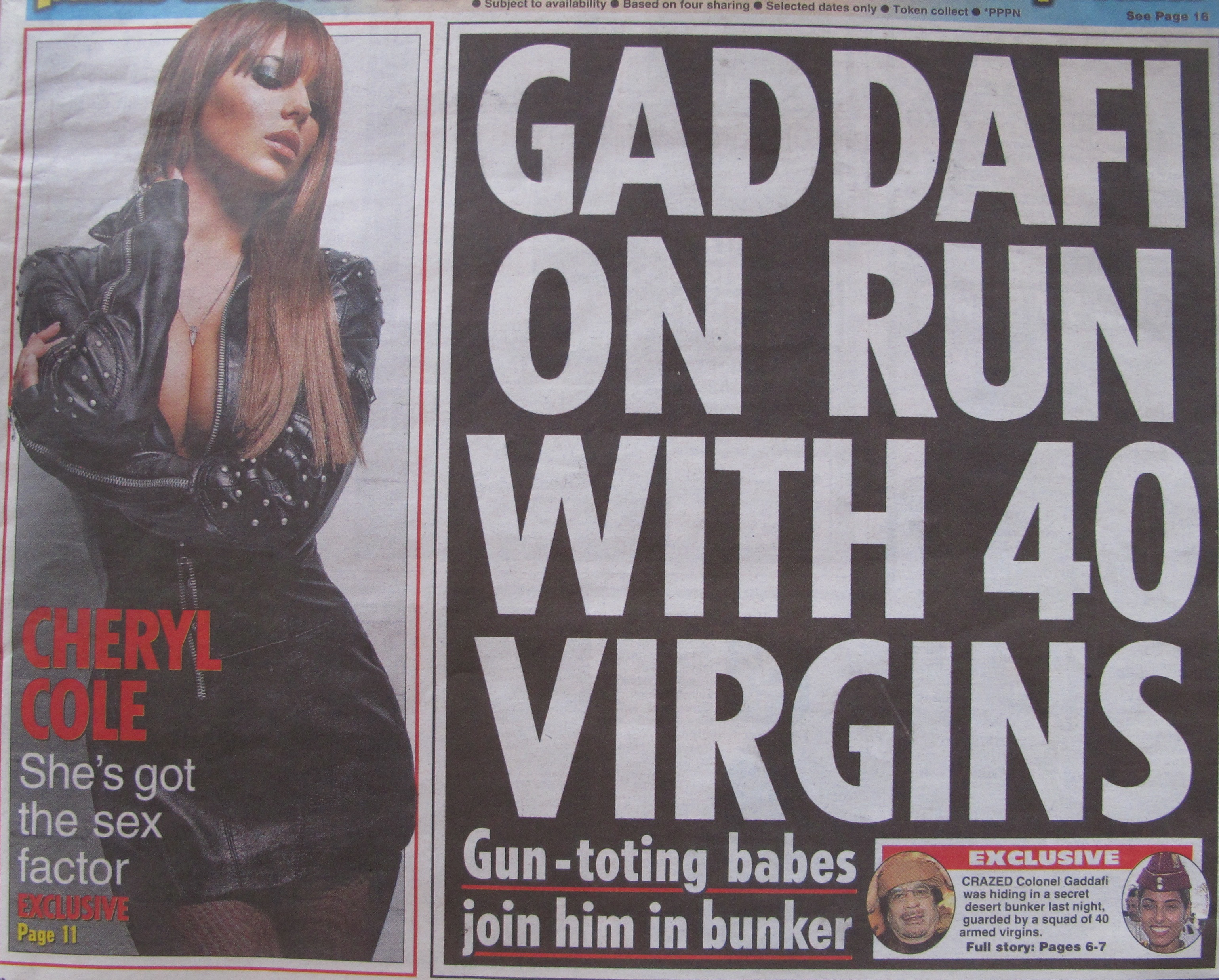When we first saw the cover of the Sunday Telegraph we did a double take. The photo of the burning MiG 29 above the fold immediately caught our attention. Combined with the left-side headline “British Forces Attack Gaddafi,” the layout suggested that the Russian-made fighter had been shot down by the RAF.
When we turned the paper over, however, the caption stated that this was actually a rebel-flown jet, brought down by friendly fire. Though we were already suspicious (the same footage was broadcast on Euronews the night before), the effect remained disconcerting. The paper communicated different messages above and below the fold.
For those familiar with British newspapers, this isn’t surprising. The Daily Telegraph is a conservative periodical. It would, in most circumstances, support government decisions to go to war, especially when such undertakings were initiated by a Tory Prime Minister. Still, though I knew the paper well enough – my parents took home delivery when I was growing up – I couldn’t help feeling somewhat upset.
As anyone who has worked in print publishing will tell you, its physicality makes it uniquely suited to influencing public opinion. So, if the first thing you see on the newsstand in the morning is a rack of images of the same MiG being shot down, with a headline like “British Forces Attack Gaddafi,” no one would shoot you for feeling confident that the RAF was going to win its latest war.
My point isn’t to extol the propagandistic advantages that print might hold over digital media, though the differences between them are significant. Rather, because I consume news via the web – for six years, my main news source has been an RSS reader – being confronted by such a deliberately designed message threw me off. As much as the above-the-fold deception was a throwback, it was also intensely instructive.
The idea that you have to lay a story out like that says a great deal about the thinking of the people who designed it. For one thing, it communicates the idea that we need reassurance, that we really need to be sold on something, otherwise we won’t buy it. For another, it also puts forth the idea that readers are still excited by violence, but need to have it presented in certain ways if they are going to accept it.
This editorial approach does not suggest a very high opinion of readers. But it’s also an approach that we’re not as familiar with in the digital realm. Though there are plenty of politically conservative newspapers online, site rollovers just don’t avail themselves to this kind of purposeful design.
My consternation at this edition of the Telegraph was more about revisiting the experience of old-school manipulation than it was about the paper’s deplorable politics. Between my MacBook, my iPhone, and cable TV, and living in Italy and Germany for the last two years, I’d become more reliant on English-language online media and television news than ever before. Ironically, though, now that I was back in the UK, where I speak the language, it was shocking to witness my media consumption regress in this manner.
The experience confirmed how unused I’ve become to print, with all of its nuanced design considerations. In the process, however, it also taught me an invaluable lesson about the risks we don’t take on the web. Not in terms of didactic modes of presentation so much as the kinds of stories we are used to commissioning. This is especially true of publishing on the Left, where an obsession with HuffPo-style opinion editorials and investigative reporting has made winning hearts and minds an afterthought. Simply put, we are content with publishing for ourselves.
One story makes this painfully apparent. It was the only other tabloid cover that caught my eye in London during the Libyan war. Printed in white, on a black background, extending from the lower right hand corner to fill nearly half of the Daily Star’s front page, the headline read, “GADDAFI ON RUN WITH 40 VIRGINS.” In the lower left hand corner, in smaller type was the statement, “Gun toting babes with him in bunker.”
In the lower right corner was a small box with pictures of Gaddafi, and a beautiful Arab woman wearing a Versace-looking army cap, visually bridging the two larger headlines. Added was the disclosure that the Gaddafi was actually being guarded by his virgins, and that they were now armed. To the left was a full body photo of a sultry female model, who just happened to be British.
At its most superficial, this was a headline looking for attention. Amidst a sea of carefully crafted newspaper covers announcing that the UK had gone to war, you got this. Next to the Financial Times, or even the Daily Telegraph, you couldn’t help but pay attention to it. Part of the appeal was that it appeared to be a totally ridiculous proposition: A notorious Arab dictator hammered by British fighter-bombers, protected by sexually inexperienced Middle Eastern women with guns. It sounded like a page from an Austin Powers script, with AKs and pussy for everyone.
The appeal was obvious. The fact that this news was not inconceivable – you could argue that such narratives are part of Muammar Gaddafi’s dictatorial “brand” – made it hard to reject the headlines completely out of hand. The Libyan war was clearly a boon to the Daily Star, as the subject matter offered the paper a rare opportunity to demonstrate that its typically exaggerated editorial approach actually has legitimate, real-world coordinates. From this perspective, the newspaper only appears ridiculous because the world is ridiculous. If only there were more events like the Libyan campaign to confirm this assessment!
At its most complex, the presentation here was another way of making the war palatable to readers. By indulging their proclivity for the bizarre and humorous, whatever might be problematic about the conflict ended up buried by the rich and anachronistic character of another shaggy dog tale of the mad Gaddafi. As a consequence, he was turned into the conflict’s true salesperson, not David Cameron, or his advisors.
Of course there had to be something gendered about it. What male reader would not want to be protected by their woman? Only the sort who have trouble being men. Like the Libyan leader, in other words, besieged by British masculinity and ready to redeem his virgins. If only he would fuck them, perhaps the RAF would go away.
It was this intensely physical component to the language of the cover that made it as bold, as assaulting, as suggestive, really, as the image of the burning Libyan MiG, published by the Telegraph. Like the MiG, it took hold of you and sexually bent you to the will of its reactionary message. Yes, the effect was more Benny Hill than stiff-upper-lip earnestness, but the political impact was similar.
It’s appropriate that this kind of communication took place in the context of a print publication. The complementary physicality is what made it so effective. As much as I acknowledge the power of the visceral, this was not the experience of news I’m used to having these days. I want to retreat to my safe, editorially curated world of specialty newspapers and stories inside my RSS reader. But maybe that impulse to preemptively filter out unpleasantness explains why the Left keeps losing ground in the public sphere.





